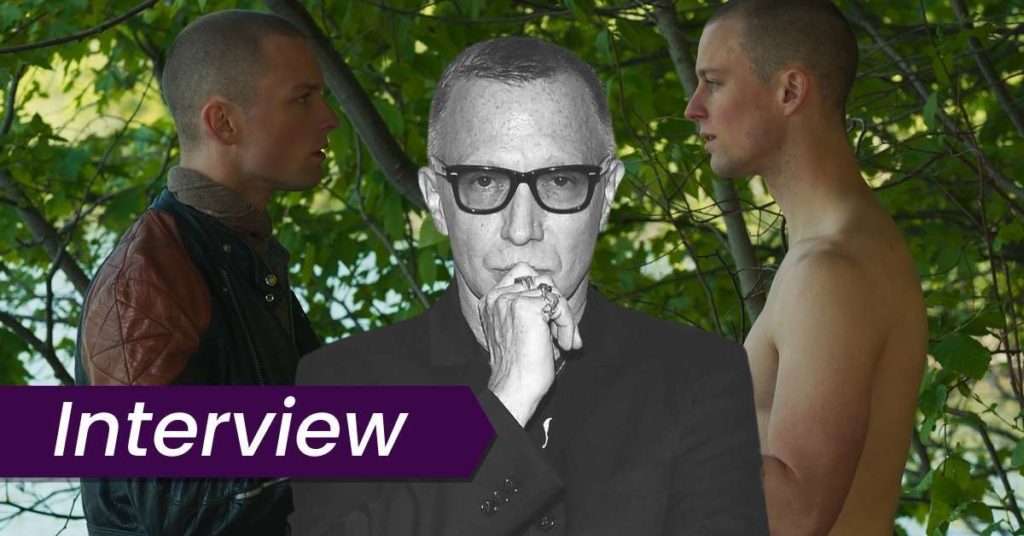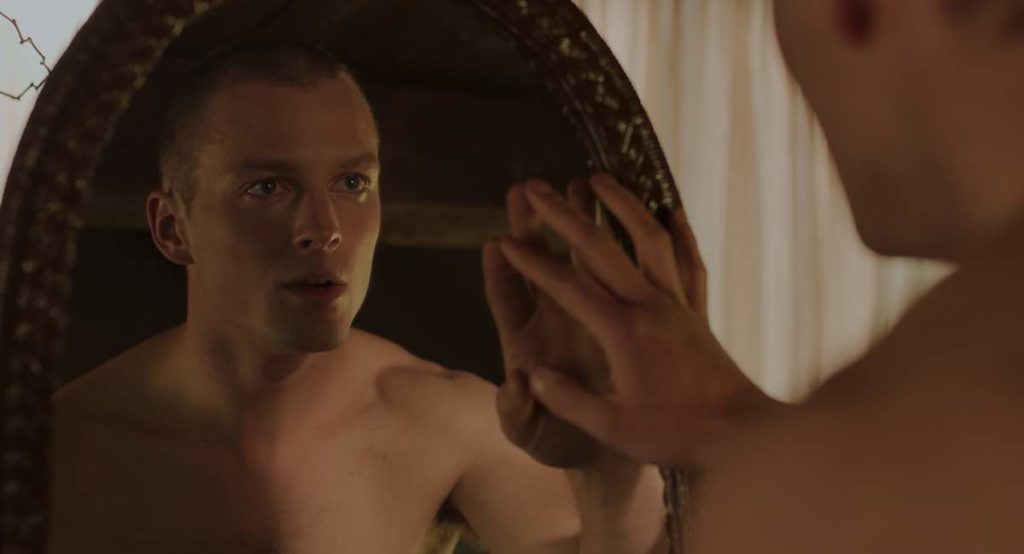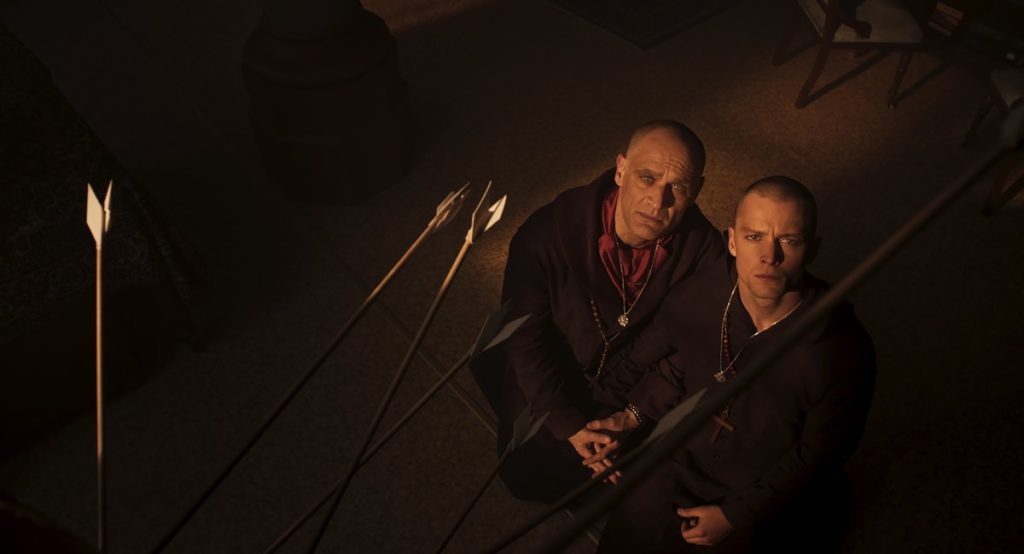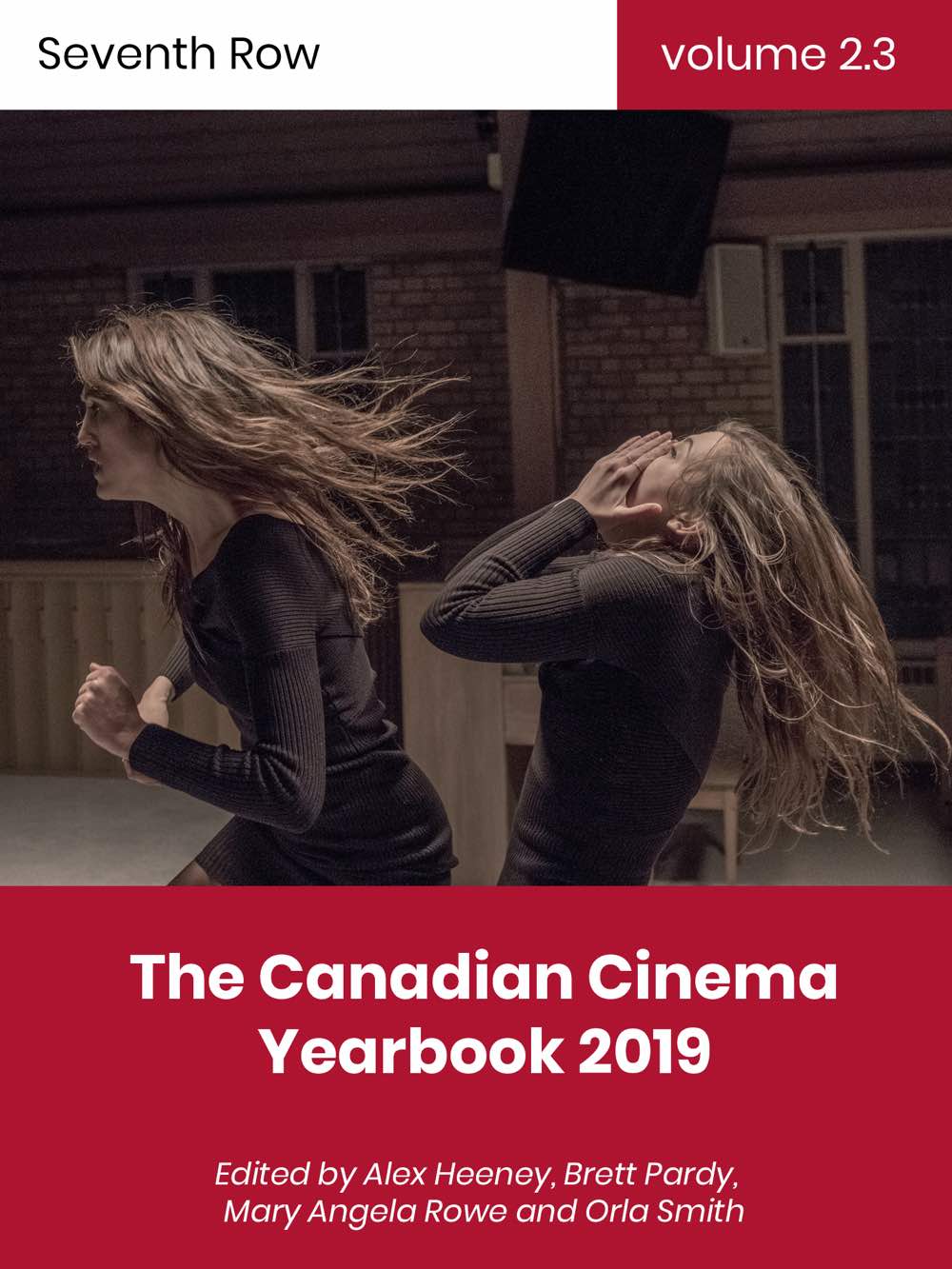After premiering at the Venice Film Festival, Bruce LaBruce’s Saint-Narcisse screened across Canada at Montreal’s Festival du Nouveau Cinema. LaBruce talked to us about updating the Narcissus myth, tackling taboos, twincest, and taking inspiration from 1970s Quebec cinema.

What if Narcissus looked into the pond and his reflection walked out of it so that they could bang each other? In Saint-Narcisse, Bruce LaBruce updates the Narcissus myth to 1972 Quebec, where a leather-clad motorcycle-riding Montrealer, Dominic (Félix-Antoine Duval), suddenly finds himself face to face with not just his image in a lake, but his identical twin, a monk named Daniel (also Félix-Antoine Duval). Twincest ensues, but that’s just one of the many bonkers and hilarious plotlines in this film that’s part camp, part melodrama, about biological and metaphorical families, in the home and the church.
Raised by his grandmother in Montreal, Dominic discovers a letter from his biological mother after his grandmother’s death, and heads out to Saint-Narcisse on a road trip to self-discovery — with a collection of neckerchiefs on hand and some very stylish boots. In Saint-Narcisse, he discovers his biological mother (Tania Kontoyanni) is considered a witch, and she lives with someone who never ages (in truth, she replaced one lover with a younger look-alike), Irene (Alexandra Petrachuk), who may or may not be his sister. Meanwhile, in a nearby monastery, Daniel spends his days playing volleyball, praying, and frolicking naked in the lake with his fellow monks, and he spends his nights with Father Andrew (Andreas Apergis), clad in sumptuous purple velvet robes, who is equal parts child molester and attractive lover.
Even before he meets his twin, Dominic spends his days taking polaroids of himself, and then masturbating to those images. He repeatedly rebuffs the advances of Irene, but finds himself spying on Daniel with fascination. When Dominic and Daniel meet, there’s a costume sight gag that’s so bizarre and off-the-wall that I was in stitches. At one point, Dominic, straight-faced, explains to Daniel that being raped by the priest is not the same as having sex with his identical twin because “we’re family.”
I’m not sure that all of the threads in Saint-Narcisse come together to a psychologically or emotionally satisfying end, but it’s a hell of a ride along the way. The acting in the film ranges from very impressive to laughably bad (or is that just camp?) that you wonder whether actual professional actors were hired. Duval shifts his physicality and demeanour so effectively that you’re convinced The Twins are played by two different actors, until they both end up with shaved heads — but half of his line deliveries are stilted. Apergis’s Father Andrew ranges from believably predatory and still attractive to Daniel, to so over the top, toward the end, that he strains believability as a human. Nevertheless, some of that unevenness is probably the point, and allows LaBruce to explore taboos — from abuse to twincest to the oppression of religion — with impressive ambiguity, acknowledging conflicting emotions and power structures.
Like Ema, Saint-Narcisse is a strong contender for the most “WTF did I just watch” film of the year, and a hell of a ride you’re not likely to forget. When the film screened at the Festival du Nouveau Cinema in November, I talked with LaBruce via Zoom about creating the film’s aesthetic, balancing challenging taboos with entertainment, and why he loves 1970s Quebec cinema.
Seventh Row (7R): What was the genesis of Saint-Narcisse?
Bruce LaBruce: The working title of the film was Twincest. My films often address issues of taboo and fetish. That was one that kept cropping up. I made Gerontophilia in Quebec in 2013, which was about gerontophilia, a fetish that some people have for the elderly.
I tend to try to look at these fetishes from an unconventional angle. I try to see the romance in these fetishes that some people find disgusting or bizarre. There’s often a human component to them that people don’t recognise. With fetish, there’s often a reverence or a sense of devotion to the love object. I try to find the human angle, and also to present them ironically in terms of romance or romantic comedy.
I started with the premise of twincest, which is a subgenre of porn. I also make porn films, but I wanted to make a more accessible, mainstream film on the same subject. That was the starting point. The idea of narcissism also seemed like a topic that is everywhere and hasn’t been explored all that much. So it was a kind of loose, cheeky retelling of the Narcissus myth.

7R: What did you want to get at about narcissism that you felt was underexplored?
Bruce LaBruce: It’s [narcissism is] so ubiquitous now. It’s everywhere. It’s so normalised. That’s why I set it in the early ‘70s. If I set this film in the contemporary world, about a character who’s taking pictures of himself all the time, it wouldn’t seem strange at all. It’s totally normalised. It stands out so starkly when you see it in a different era when that wasn’t the norm, and it does seem quite bizarre and unusual. Narcissism now is almost like a white noise. It’s everywhere.
There’s a lot of talk about toxic narcissism in psychological terms, but I think narcissism is a lot more complicated than that. In the film, there’s good narcissism and bad narcissism. The characters of the mother, Beatrice, and Father Andrew, both have narcissistic personalities because they both pursue their own desires without taking into consideration how profoundly it might affect the people around them. That’s a certain kind of narcissism that’s not so good.
The twin narcissism you can maybe understand, even the twincest, because if you were presented with someone identical to you, and you had intimate proximity with that person, people can wrap their minds around the fact that there might be sexual interest there.
7R: What made you want to choose this particular setting of both Quebec and the ‘70s for Saint-Narcisse?
Bruce LaBruce: Quebec is the only place in Canada that has generously supported me. (laughs) It’s hard for me to get my films financed in Ontario, for some reason.There’s such a strong cultural identity in Quebec in the arts and culture. They appreciate work that’s really unusual or challenging or based more on the idea of European art cinema.
Quebec cinema from the ‘70s has always fascinated me. Paul Almond is the filmmaker I’m referencing the most, and he made a trilogy with Geneviève Bujold — Isabel, Act of the Heart, and Journey — that really explore taboos. Isabel has these incestuous implications, and it’s kind of a spooky film set in a rural environment. In Act of the Heart, you have Donald Sutherland as a priest having sex with Geneviève Bujold on the altar of the church, and then she goes to the park and sets herself on fire. When I saw that on TV on the CBC as a kid, it had a profound effect on me. I was so intrigued and confused: what could drive them to such passions and self destruction?
This idea of sexual repression and the family and the church is built into Quebec culture and has been explored a lot in Quebec cinema. Bons débarras is one of my favourite Quebec films, and it has almost incestuous implications between the mother and daughter. I was really thinking about that, too, with Beatrice and Irene.
7R: How did you build the aesthetic for Saint-Narcisse? With the costumes, production design, and cinematography, it’s such a rich world you’ve created.
Bruce LaBruce: It is the biggest budget I’ve ever had to work with, which is still not that big, and we only had 22 days to shoot it. I wanted it to look like and have the atmosphere of a ‘70s Quebec film. To that end, we got Michel La Veaux to shoot the film; he’s been around since the ‘70s as a filmmaker and has worked with all the great ‘70s Quebec auteurs like Michel Brault, Francis Mankiewicz, etc… He really brought that authenticity to it.
We tried to do it all in camera and not in post, so he chose lenses from the era; we used these enormous zoom lenses. The way he lit it was by using lighting kits that are more consistent with that style from the ‘70s. The art director, Hercule [Desjardins], just had a real sense of the era and the costume designer, Valérie Gagnon-Hamel, did, as well. It was a really great team effort. Everyone was really dedicated to pulling off this look.
7R: I feel like Saint-Narcisse is a celebration of the neckerchief.
Bruce LaBruce: Yeah, Valérie was amazing, she had all these little details in terms of the costumes. She had a lot of fun. For me, Félix’s boots are very important in the film.
7R: Yes!
Bruce LaBruce: I wanted it to look stylish, and she brought a real sense of style to it.

7R: How did you design the church and the monks’ robes? It’s sort of a gothic space, but also very sumptuous.
Bruce LaBruce: Valérie [Gagnon-Hamel] and I worked really closely. I worked with all the department heads pretty closely. Valérie gave me all these samples of fabric and stuff. We even consulted with Michel La Veaux on what fabrics would work best in a dark interior that would stand out from the background.
The locations also were just hugely important. We had one monastery that we were going to shoot in, which was massive, in Oka, but they didn’t like the script very much. I think they actually might have Googled me. So we weren’t able to use that. But the locations people found a nunnery that was recently sold to the Quebec government, and it had never been used as a location before. We were extremely lucky to get that because it’s a beautiful location with the huge, vaulted, painted ceilings, and everything. Hercule had to butch it up, make it more masculine. That was partly done through lighting and partly through adding more masculine visual motifs.
7R: How did you approach casting the film?
Bruce LaBruce: Maxime Giroux, the casting director, brought in actors he considered appropriate for the roles. For the twins, we looked at maybe 15 actors. Félix [-Antoine Duval] really stood out for me. It’s a film about narcissists, so it had to be someone with classical beauty, but also, he had a warmth and curiosity about the role. He was really open to exploring it. He was also just super nice, and I like to work with nice people.
Andreas Apergis, who plays Father Andrew, just blew me away in his audition. He nailed it so hard. The female roles were a bit more difficult. There’s that earth mother thing that Beatrice has which is a bit elusive. And Irene is just this fresh faced, open girl with a cynical edge. It was challenging. But I think they’re both great in the film.
7R: Saint-Narcisse is very funny, so I’m wondering how you think about putting that comedy together. Some of it is sight gags, like the naked priest who is wearing nothing but sneakers. I laughed so hard at that I was in pain.
Bruce LaBruce: I try to do it pretty subtly. There’s even gag lines in the film. I’m really quite skeptical about bad gag lines in action movies and stuff that often seems so corny or gratuitous. I try to incorporate some of those kinds of lines like when Irene says, “Then go fuck yourself.” It could be corny, but I try to make it make sense in the scene as something someone would actually say. And it’s the way she delivers it, too. Her other line, “He only takes pictures of himself, I mean who does that?” could be too on the nose, but it works because it reinforces how bizarre that kind of behaviour is.
I think the script, which I collaborated on very closely with Martin Girard, has that melodramatic component, but it does dig into the psychology of the characters. We didn’t have a lot of time for shooting so we didn’t do a lot of takes, but I would get them to do a more over-the-top take, which we ended up rarely using.
Overall, it was more about being pretty natural, their acting, within the range of melodrama. If you watch old Hollywood melodramas now, which I love, the acting is so broad it’s kind of crazy. Their acting [in Saint-Narcisse] was more consistent with the psychosexual films of the ‘70s, that are more serious in intent.
I cut out quite a bit of the more heavy-handed dialogue. The kind of humour that’s in it, it’s a camp humour. For me, camp works best when it’s played straight, when people play the dramatic scenes straight.
My editor, Hubert Hayaud, who is amazing — he just thoroughly got the film — and I would cut out some of the more over-the-top takes where people were maybe getting too melodramatic. We tried to keep it in the range of dramatic believability.
7R: When you’re thinking about the twins, how different did you want them to be? To some degree, at the beginning, I thought they could be two completely different actors, and then they converged a bit.
Bruce LaBruce: Yeah, I’m really happy that some people tell me that, at some points, they felt like different actors. It’s such a tribute to Félix. But we also kept the CGI twin effects to a minimum. There’s maybe 6 or 8 face replacement shots; the rest is split screen, which is the standard for old twin movies like The Parent Trap or the old Bette Davis twin movies like A Stolen Life and Dead Ringer. Also a body double, which gives it a more naturalistic effect.
The scene where the twins make love, we had initially planned to have four or five hours to shoot it, and I had an elaborate shot list. But then, because of time constraints, we had like an hour to shoot it. I had meant it to be a little more expressionistic, but we just shot Felix and the body double making out together and then edited it so it’s hard to tell who’s who. It gives it an authentic intimacy, I think. It doesn’t seem like a special effect.
7R: Did you guys work together to think about how the physicality of the two twins should differ?
Bruce LaBruce: Dominic has been raised in freedom so he’s more loose and unselfconscious, and Daniel is a little fidgety. We worked on his body language. He’s a smoker; he’s reluctant with his sexuality; he knows subconsciously that he’s been exploited, but at the same time, he does have genuine sexual feelings for Father Andrew.
I think that is more realistic in terms of what happens often with sexual exploitation. Even Oprah acknowledged that what’s disturbing about the sexual exploitation of children is that they experience pleasure. The implications of what’s happening to them is almost beyond their comprehension. It’s a disturbing and complex psychology. So he has both those feelings of genuine sexuality and love with this man, but ultimately. it takes his twin, an objective outsider and also his other half, to explain to him that it’s inappropriate.
Before they make love, we only see Dominic’s sexual fantasy, when he has sex with the girl in the laundromat, and that’s obviously almost like his pornographic fantasy. But we don’t know much about his sexuality. We shot a scene where he has a girlfriend and breaks up with his girlfriend, but we cut that scene and left it as a bit of an open question what his sexuality actually is.

7R: That’s interesting because he’s not interested in his sister, but his twin is interested in his sister.
Bruce LaBruce: I just think that’s a great joke because there’s at least three scenes where she tries to kiss Dominic, and he or something always interrupts. When finally, she can’t hold back any longer, and she offers this wide open kiss, it’s not Dominic. It’s an ironic comment on the arbitrariness of love and that the twins are interchangeable.
It’s more about the fact that there is that weird prohibition set up, because, from the beginning, Dominic doesn’t know whether she’s his sister or not. When Daniel comes in, he doesn’t have that prohibition, because he knows exactly who she is. And also, he’s never had a chance to explore his sexuality, so it makes sense that he would take that opportunity to experiment. But there’s a lot of irony there and a weird poetic justice to it.
7R: The successful kiss felt right out of Twelfth Night.
Bruce LaBruce: I love that comparison.
7R: There’s a good history of twins as a way to explore queerness. Were you thinking about those other influences when writing and making Saint-Narcisse?
Bruce LaBruce: That’s really interesting because it never consciously occurred to me, but of course, I’ve read Twelfth Night and seen it performed. You’re right, there’s that Shakespearean element to it. And examples in Hollywood films, as well.
There’s a lot going on in terms of queer politics, and in some ways, it’s politically incorrect because people don’t necessarily want to see characters who start out [in a] queer [relationship] and experiment with heterosexual sexuality. But the film mixes it up so much that it becomes kind of polyamorous by the end.
There’s so many parallels going on in the film, like the parallel between the mother-and-daughter implied incest — even though Beatrice isn’t her actual mother, she’s her mother figure, but there’s an implied sexual intimacy — and in the monastery, there’s the symbolic father and incest with his son. So those two worlds are kind of parallel. You also have the implied brother-sister incest and then the actual brother-brother incest.
7R: You’ve talked a lot about exploring taboos. How were you thinking about using camp as a way to explore taboos in Saint-Narcisse?
Bruce LaBruce: Both camp and melodrama afford you a lot of room for those kinds of impertinent [ideas]. The script sets up a whole scenario where all these taboos are presented in an elaborate way. Camp is partly about that kind of melodrama and that kind of outrageousness that can [help] you get away with certain things.
One of the most famous Hollywood melodramas, Peyton Place, is based on the stepfather raping the daughter. So it’s kind of built into the genre, those kinds of taboos and people becoming so overwrought because those taboos are transgressed.
7R: I wanted to ask about the final scene of the film, the song choice of “Family Affair” by Sly and the Family Stone, because it’s really great. What a great way to close the film.
Bruce LaBruce: We were lucky to get that song. The producer managed to make some kind of deal. It just occurred to me in editing, and then we tried it, and I thought, Is it too on the nose or ironic? But the lyrics fit the scenario so well, talking about two different children. And it’s also really from the era; it came out in the same year the film is set, 1972, as is the opening song, “Where Evil Grows” by The Poppy Family.
“Family Affair” is so consistent with the tone of the film where it’s kind of romantic and sad. The idea of ironically using songs, especially on TV series, sometimes, it’s done well, and other times, it’s really overused. I was a bit reluctant, but I thought it was a nice way to end the film.
The ending is kind of ironic: the family comes together, which is what you expect to happen in the film, but there are so many sexual permutations going on that it’s a kind of strange family reunion and with the new offspring and everything. You don’t know which twin exactly is the father, and you don’t know, are Beatrice and Irene still intimate? It raises so many questions but ties it together with a gently ironic romanticism. It leaves people with something nice to leave the theatre with.
You could be missing out on films like Saint-Narcisse at film festivals near you.
Subscribe to the Seventh Row newsletter to stay in the know.
Subscribers to our FREE newsletter get an email every Friday which details some of the best new streaming options in Canada, the US, and the UK.
Click here to subscribe to the Seventh Row newsletter.


